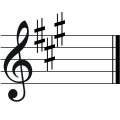F-sharp minor facts for kids
 |
||
| Relative key | A major | |
|---|---|---|
| Parallel key | F♯ major | |
| Notes in this scale | ||
| F♯, G♯, A, B, C♯, D, E, F♯ | ||
F-sharp minor is a musical scale that starts on the note F sharp. It is a minor scale, which often sounds more serious or sad than a major scale. It has three sharps in its key signature.
Its relative major key is A major. This means they share the same notes, but start on different pitches. Some musicians think F-sharp minor sounds sad or serious.
The composer Harry Farjeon described F-sharp minor as "light red." He also said that Felix Mendelssohn used this key when writing very emotional music. Johann Mattheson, another musician, wrote that F-sharp minor can sound like it leads to great distress. However, he also felt it was more gentle and love-sick than deadly.
Famous Music in F-sharp Minor
Not many symphonies are written in F-sharp minor. One famous example is Haydn's Farewell Symphony. This symphony is known for its unique ending. George Frederick Bristow and Dora Pejačević also wrote symphonies in this key.
Many piano pieces have been composed in F-sharp minor. Mozart's only work in this key is the second movement of his Piano Concerto No. 23. This concerto is actually in A major.
Frédéric Chopin wrote two of his 52 mazurkas and one of his nocturnes in F-sharp minor. However, he seemed to prefer the related key of C-sharp minor. Alexander Scriabin's Piano Sonata No. 3 is also in this key. The third movement of Beethoven's famous "Hammerklavier" Piano Sonata is also in F-sharp minor.
Both Max Reger's and Michael Tippett's second string quartets are in this key. Shostakovich's seventh string quartet also uses F-sharp minor.
Understanding Scales and Keys
| Diatonic Scales and Keys | |||||||||||||||||||||||||||||||||||||||||||||||||||||||
|---|---|---|---|---|---|---|---|---|---|---|---|---|---|---|---|---|---|---|---|---|---|---|---|---|---|---|---|---|---|---|---|---|---|---|---|---|---|---|---|---|---|---|---|---|---|---|---|---|---|---|---|---|---|---|---|
|
|||||||||||||||||||||||||||||||||||||||||||||||||||||||
| The table shows the number of sharps or flats in each scale. Minor scales are written in lower case. | |||||||||||||||||||||||||||||||||||||||||||||||||||||||
The circle of fifths is a diagram that shows the relationships among the 12 tones of the chromatic scale. It helps musicians understand how different keys are related to each other. F-sharp minor is part of this system.
See also
 In Spanish: Fa sostenido menor para niños
In Spanish: Fa sostenido menor para niños


